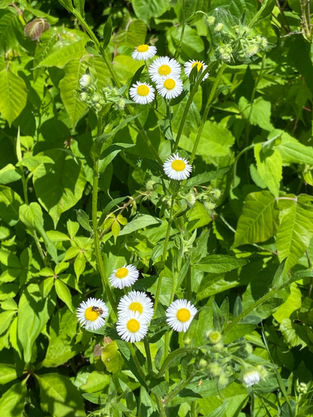Daisy Fleabane
Common Name: Daisy Fleabane.
Scientific Name: Erigeron Strigosus.
What to look for? “Daisy” with yellow center surrounded by white petals! As its name – Daisy Fleabane – suggests, this wildflower has a daisy-like appearance. Each plant has multiple flowerheads sitting atop the tall, light green to purplish green stem. Each flowerhead has upwards of 40 or more white, slender ray florets, or petals, that surround numerous disk florets. The corollas of the disk florets are yellow, densely bunched, very tiny and tubular in shape – that yellow middle is not a single floret. The lower half of the stem has leaves but is unbranched; with lateral stems formed above that hold each flowerhead. The Daisy Fleabane spreads by reseeding itself and will occasionally form colonies.
Where can they be found at Carillon Stonegate Pond? From late spring and through summer, you can find the Daisy Fleabane scattered around the walking path going north along Carillon Stonegate Ponds and the fields adjacent to the woodlands.
How big are they? Daisy Fleabane grow to as much as three feet tall. The leaves are up to four inches long and less than one inch across. Each flowerhead is about ¾ of an inch across (nickel size).
Where do they grow and thrive? The Daisy Fleabane is native to North America and is fairly common across most of Illinois. Habitats include moist to dry prairies, open woods, waste ground, pastures and abandoned fields, areas along railroads and roadsides, open woods, and other higher quality natural or disturbed areas.
When do they bloom? The blooming period of the Daisy Fleabane occurs from late spring to mid-summer, lasting a couple of months for a colony of these plants. After the blooming period, the foliage of the Daisy Fleabane slowly withers away and its seeds are released.
Do birds, insects or other wildlife associate with this plant? Small bees and flies visit the flowerheads of Daisy Fleabane for nectar or pollen. You may occasionally find wasps and small butterflies on these flowerheads. The larvae of some beetles, moths, grasshoppers, and crickets find the Daisy Fleabane to be a suitable host plant.
Interesting Facts About the Daisy Fleabane:
-
There are a number of species of Fleabanes, characterized by numerous rays of various colors surrounding a flat yellow disc.
-
The Daisy Fleabane is a pioneer species - those hardy species that move into disturbed areas first such as from a fire, a natural disaster like a tornado or other activity like construction, plowing or land restoration.
-
The common name “fleabane” comes from a folk belief that fleabane repels fleas, which it apparently does not.
For more information on the Daisy Fleabane and sources of information used in this blog (these are several of the sources that I am using to learn as I blog), please visit Illinois Wildflowers, University of Texas Wildflower Center, Minnesota Wildflowers, and Friends of the Wildflower Garden.
The Carillon at Stonegate community is very fortunate to have a variety of wetland, forest and prairie environments conducive to a variety of birds and other wildlife, insects and plants. Our community and the Kane County Forest Preserve do an exceptional job in maintaining this natural environment – both for the benefit of the birds and wildlife and for our residents to enjoy.
Take a hike and see what you can find – and identify!








